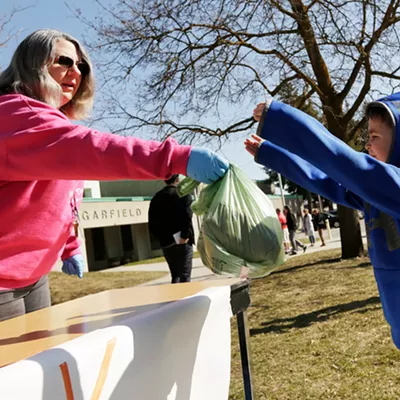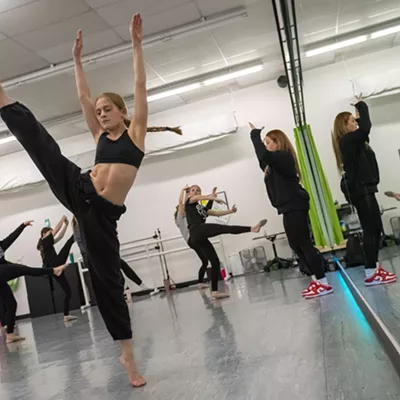When classes begin next week, Spokane middle schoolers should have an easier time — thanks to a $495 million voter-approved bond and a new cohort of sixth graders.
Five years ago, Spokane voters overwhelmingly approved the largest ever Spokane Public Schools bond. With the last of the projects under that nearly half-a-billion-dollar bond wrapping up, and middle schools expanded to include sixth graders, district Superintendent Adam Swinyard says middle school will no longer be just one big transitional period.
"These kids spent half of seventh grade transitioning and getting ready for middle school and then the second half of eighth getting ready and ramping up for high school," he says.
Swinyard says it's just one of the many successes of the bond, which has $50 million to spare as the district intends to put another bond before voters in 2024.
Between three entirely new middle schools, three replacement middle schools and four other major improvement projects, the district says it has lowered elementary school class sizes and increased student safety.
This 2018 school bond also marked the beginning of a partnership between the school district and the city, since it was done in conjunction with the $77 million public libraries bond, which paid to create three new libraries and modernize four others. The school bond passed with 69 percent of the vote, and the library bond with 65 percent.
Their partnership helped during construction — like when Shaw Middle School's library doubled as the Hillyard Public Library. But it also updated the library collections at all nine middle schools, and not just the ones undergoing construction.
"We gained a vast quantity of opportunities for our students in library education, and books are fresh in all of our systems without spending money because we had a partnership with that library system," says Greg Forsyth, the district's capital projects manager.
But this was only the beginning. District officials had to decide who would go to these schools. And that took updating the district's school boundaries.
Mark Anderson grins as he recalls the exact time and date that the district's leaders agreed on changes to the boundaries. It was halfway through his final day as associate superintendent — 11:25 am, June 30, 2021.
"Students said they lacked a sense of belonging in the building areas that felt comfortable. So we developed those areas."
According to Anderson, who retired but is now an adviser for the district, the district boundaries hadn't changed in more than four decades, so there was tons of work to be done.
The district formed a 60-person committee that held community forums and webinars over two years to reconfigure the boundary.
While Swinyard says there isn't one perfect boundary map, this one is pretty close.
"The kids who go to elementary school together then all go to the same middle and the same high school," Swinyard says. "It brings us back to that core value of a sense of belonging now that there's that continuity of experience for the kids."
Alongside a committee for boundary decisions, the district hosted a design summit including students, staff, parents and community members.
"Students said they lacked a sense of belonging in the building areas that felt comfortable," Forsyth says. "So we developed those areas, whether it's little nooks off to the side or large gathering spaces."
The district even added playgrounds to the middle schools — something that was once kept solely to elementary schools.
After successfully completing most of these projects, Forsyth says he feels fortunate to have been involved in the process.
"The community gave us the opportunity to rethink and really find success for that middle school grade, which for years was neglected," he says. "We either tried to push high school down, or we tried to pull elementary up, and we didn't make it its own place, so I think it's been very satisfying to see that." ♦
CARLA PEPERZAK MIDDLE SCHOOL
LOCATION: 2620 E 63rd Ave.
BUILDING AREA: 150,000 square feet
STUDENT CAPACITY: 850
CONSTRUCTION BUDGET: $76.8 million
NAMESAKE: Carla Olman Peperzak, who was born in 1923, was a Dutch resistance operative and Holocaust freedom fighter during WWII. Growing up in the Netherlands, Peperzak graduated from high school the same year that Germany invaded the country. At 18 she joined the Dutch resistance, first helping to save her family members and later securing hiding places for Jewish people. The education advocate and memoirist has been sharing her story in Spokane since she moved here in 2004.
UNIQUE ATTRIBUTE: Expansive views from each classroom and common space in Peperzak are meant to inspire environmental awareness in students as they receive three years of formative education.
DENNY YASUHARA MIDDLE SCHOOL
LOCATION: 2701 N. Perry St.
BUILDING AREA: 140,000 square feet
STUDENT CAPACITY: 750
CONSTRUCTION BUDGET: $70.6 million
NAMESAKE: Denny Yasuhara was a math and science teacher in Spokane for nearly 30 years. As a child in Bonners Ferry, Idaho, during World War II his Japanese American family faced persecution from both neighbors and the government. So they moved to Spokane, where years later "Mr. Yas" would begin teaching at Logan Elementary. He also would found Hifumi En on the South Hill, which he had originally envisioned in 1965 as a home for elderly, disabled or veteran Japanese Americans. When he died in 2002, the Washington Post and Japan Times ran his obituary.
UNIQUE ATTRIBUTE: Student commons through the middle of Yasuhara provide a big space for gathering. Nutrition and learning commons connect with special learning classrooms along the full length of the space.
PAULINE PASCAL FLETT MIDDLE SCHOOL
LOCATION: 4830 W. Wellesley Ave.
BUILDING AREA: 140,000 square feet
STUDENT CAPACITY: 750
CONSTRUCTION BUDGET: $66.9 million
NAMESAKE: Trailblazing linguist Pauline Pascal Flett spent more than five decades documenting the Spokane Salish dialect once considered endangered. She grew up on the Spokane Indian Reservation and didn't begin to speak English until she attended school. In 1992, Flett was granted an honorary master's degree from Eastern Washington University and then went on to co-write the first Spokane-English dictionary with Barry Carlson in 1996. Many credit her with ensuring that the language did not go extinct. She died in 2020. Her notes are kept at the Smithsonian Institution.
UNIQUE ATTRIBUTE: Flett's design was inspired by the Spokane River and the Bowl and Pitcher. rock formation. The interior represents a nod to the natural beauty of the land the school was built on. Forsyth says bringing nature inside the school was a passion of both the staff and students.
SHAW MIDDLE SCHOOL
LOCATION: 4106 N Cook St.
BUILDING AREA: 150,000 square feet
STUDENT CAPACITY: 1,000
CONSTRUCTION BUDGET: $66 million
NAMESAKE: John Shaw was an administrator with Spokane Public Schools who worked many positions including the district's top spot — superintendent. His namesake school was at one time the largest middle school in Washington state with more than 1,000 students.
UNIQUE ATTRIBUTE: Shaw Middle School is also home to the new Hillyard Public Library, effectively connecting the two. This also ties the library system at the school to the city's library system, meaning if a book can't be found here, it may be found through the Spokane Public Library.
SACAJAWEA MIDDLE SCHOOL
LOCATION: 401 E 33rd Ave.
BUILDING AREA: 140,000 square feet
STUDENT CAPACITY: 850
CONSTRUCTION BUDGET: $78.1 million
NAMESAKE: Sacajawea was a part of the Agaideka (Lemhi-Shoshone) Tribe in the late 1700s and early 1800s. She is known as an essential member of the expedition to discover routes through the North American West to the Pacific Ocean. Scholars believe she helped establish contact with other Native American people and contributed to the expedition’s knowledge of the region. Her namesake was later adopted as a symbol of women’s independence by the National American Woman Suffrage Association.
UNIQUE ATTRIBUTE: The new building mashes the past and present with a traditional red brick schoolhouse design inspiration diffused with natural light throughout.

























